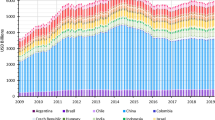Abstract
The premise of the paper is that the fervor for foreign exchange market intervention by U.S, and European monetary authorities has ebbed in recent years. A pattern of initial belief in the effectiveness of foreign exchange market intervention has recently been eroded, as is revealed by the absence of intervention in circumstances that in earlier times would have invoked it. Only the Bank of Japan among central banks of the developed world has not thusfar abandoned its faith that intervention can change the relative value of the yen as determined by market forces to conform with its notion of what that value should be. To explain why U.S. and European monetary authorities no longer believe that intervention is a tool that works, I review the equivocal record of past episodes, the inconclusive results of empirical research, and the problems of implementation that intervention advocates ignore.
Similar content being viewed by others
References
Catte, Piero, Giampaolo Galli, and Salvatore Rebecchini. “Concerted Interventions and the Dollar: An Analysis of Daily Data.” In: Peter B. Kenen, Franco Papadia, and Franco Saccomanni, eds., The International Monetary System. Cambridge: Cambridge University Press, 1994, 201-239.
Clarida, Richard H. “G3 Exchange Rate Relationships: A Recap of the Record and a Review of Proposals for Change.” NBER Working Paper 7434, 1999.
Dominguez, Kathryn M. “Market Responses to Coordinated Central Bank Intervention.” Carnegie Rochester Conference Series on Public Policy 32 (1990), 121-163.
Dominguez, Kathryn M., and Jeffrey A. Frankel. Does Foreign Exchange Intervention Work? Washington, D.C.: Institute for International Economics, 1993a.
Dominguez, Kathryn M., and Jeffrey A. Frankel. “Does Foreign Exchange Intervention Matter: Disentangling the Portfolio and Expectations Effects for the Mark.” American Economic Review 83 (1993b), 1356-1369.
Edison, Hali J. “The Effectiveness of Central Bank Intervention: A Survey of the Post-1982 Literature.” Special Papers on International Finance. Princeton: Princeton University, 1993.
Frankel, Jeffrey A. “In Search of the Exchange Risk Premium: A Six-Country Test Assuming Mean-Variance Optimization.” Journal of International Money and Finance 1 (1982), 255-274.
Frankel, Jeffrey A. “The Making of Exchange Rate Policy in the 1980s.” In: Martin Feldstein, ed., American Economic Policy in the 1980s. Chicago: University of Chicago Press, 1994, pp. 293-341.
Hodrick, Robert J. “The Empirical Evidence on the Efficiency of Forward and Futures Foreign Exchange Markets.” Fundamentals of Pure and Applied Economics 24 (1987).
Humpage, Owen F. “Institutional Aspects of U.S. Intervention.” Federal Reserve Bank of Cleveland. Economic Review 30 (1994), 2-19.
Kaminsky, Graciela L., and Karen K. Lewis. “Does Foreign Exchange Intervention Signal Future Monetary Policy?” Journal of Monetary Economics 37 (1996), 285-312.
Marston, Richard C. “Exchange Rate Policy Reconsidered.” In: Martin Feldstein, ed., International Economic Cooperation. Chicago: University of Chicago Press, 1988, pp. 79-136.
McKinnon, Ronald I. “International Money: Dollars, Euros, or Yen?” Mimeo, Stanford University, 1998.
McKinnon, Ronald I. “The Foreign Exchange Origins of Japan's Liquidity Trap.” Cato Institute 17th Annual Monetary Conference, 1999.
Mussa, Michael. “Empirical Regularities in the Behavior of Exchange Rates and Theories of the Foreign Exchange Market.” Carnegie Rochester Conference Series on Public Policy 11 (1979), 9-57.
Obstfeld, Maurice. “The Effectiveness of Foreign-Exchange Intervention: Recent Experience, 1985-1988.” In: William H. Branson, Jacob A. Frenkel, and Morris Goldstein, eds., International Policy Coordination and Exchange Rate Fluctuations. Chicago: Chicago University Press, 1990, 197-237.
Rogoff, Kenneth. “On the Effects of Sterilized Intervention: An Analysis of Weekly Data.” Journal of Monetary Economics 14 (1984), 133-150.
Rose, Andrew K. “Comment.” In: Jeffrey A. Frankel, Giampaolo Galli, and Alberto Giovannini, eds., The Microstructure of Foreign Exchange Markets. Chicago: University of Chicago Press, 1996, pp. 294-296.
Smith, Ralph W., and Brian F. Madigan. “Exchange Rate Management and Monetary Policy in the United States.” In: Exchange Market Intervention and Monetary Policy. Basle: BIS 1988, pp. 188-200.
Truman, Edwin M. “Discussion.” In: Peter B. Kenen, Franco Papadia, and Franco Saccomanni, eds., The International Monetary System. Cambridge: Cambridge University Press, 1994, pp. 248-254.
Volcker, Paul. The Quest for Exchange Rate Stability. Washington, D.C.: Institute for International Economics, 1995.
Weber, Axel A. “Foreign Exchange Intervention and International Policy Coordination: Comparing the G-3 and EMS Experience.” In: Matthew B. Canzoneri, Wilfred J. Eithier, and Vittorio Grilli, eds., The New Transatlantic Economy. Cambridge: Cambridge University Press, 1996, pp. 54-113.
Williamson, John. “Target Zones and the Management of the Dollar.” Brookings Papers on Economic Activity 1 (1986), 165-174.
Williamson, John. Estimating Equilibrium Exchange Rates. Washington, D.C.: Institute for International Economics, 1994.
Williamson, John. “Crawling Bands or Monitoring Bands.” International Finance 1 (1998), 1-24.
Author information
Authors and Affiliations
Rights and permissions
About this article
Cite this article
Schwartz, A.J. The Rise and Fall of Foreign Exchange Market Intervention as a Policy Tool. Journal of Financial Services Research 18, 319–339 (2000). https://doi.org/10.1023/A:1026567526906
Issue Date:
DOI: https://doi.org/10.1023/A:1026567526906




